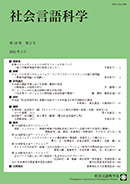Volume 18, Issue 2
Displaying 1-12 of 12 articles from this issue
- |<
- <
- 1
- >
- >|
Prefatory Note
-
2016Volume 18Issue 2 Pages 1-2
Published: March 31, 2016
Released on J-STAGE: November 28, 2016
Download PDF (227K)
Special Contribution
-
2016Volume 18Issue 2 Pages 3-18
Published: March 31, 2016
Released on J-STAGE: November 28, 2016
Download PDF (1466K)
Research Papers
-
2016Volume 18Issue 2 Pages 19-36
Published: March 31, 2016
Released on J-STAGE: November 28, 2016
Download PDF (622K) -
2016Volume 18Issue 2 Pages 37-52
Published: March 31, 2016
Released on J-STAGE: November 28, 2016
Download PDF (1625K)
Study Material
-
2016Volume 18Issue 2 Pages 53-69
Published: March 31, 2016
Released on J-STAGE: November 28, 2016
Download PDF (835K)
Book Reviews
-
2016Volume 18Issue 2 Pages 70-72
Published: March 31, 2016
Released on J-STAGE: November 28, 2016
Download PDF (249K) -
2016Volume 18Issue 2 Pages 73-75
Published: March 31, 2016
Released on J-STAGE: November 28, 2016
Download PDF (265K)
Reports
-
2016Volume 18Issue 2 Pages 76-81
Published: March 31, 2016
Released on J-STAGE: November 28, 2016
Download PDF (343K) -
2016Volume 18Issue 2 Pages 82-87
Published: March 31, 2016
Released on J-STAGE: November 28, 2016
Download PDF (400K) -
2016Volume 18Issue 2 Pages 88-93
Published: March 31, 2016
Released on J-STAGE: November 28, 2016
Download PDF (358K) -
2016Volume 18Issue 2 Pages 94-99
Published: March 31, 2016
Released on J-STAGE: November 28, 2016
Download PDF (424K) -
2016Volume 18Issue 2 Pages 100-101
Published: March 31, 2016
Released on J-STAGE: November 28, 2016
Download PDF (204K)
- |<
- <
- 1
- >
- >|
